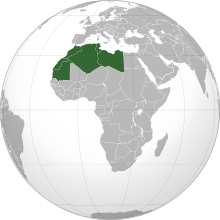- North African cuisine
-
Dinner in Morocco

North Africa, the northernmost part of Africa along the Mediterranean Sea[1] includes the nations of Algeria, Egypt, Libya, Morocco, and Tunisia. The region has a high degree of geographic, political, social, economic and cultural diversity which influences the region's cuisine and the culinary style.
Over several centuries traders, travelers, invaders, migrants and immigrants all have influenced the cuisine of North Africa. The Phoenicians of the 1st century brought sausages, the Carthaginians introduced wheat and its by-product, semolina. The Berbers, adapted this into couscous, one of the main staple diet.[1] Olives and olive oils were introduced before the arrival of the Romans. From the 7th century onwards, the Arabs[2] introduced a variety of spices, like saffron, nutmeg, cinnamon, ginger[3] and cloves, which contributed and influenced the culinary culture of North Africa. The Ottoman Turks brought sweet pastries and other bakery products, and from the New World, North Africa received potatoes, tomatoes, zucchini and chili peppers.
Contents
Common foods and dishes
In North African cuisine, the most common staple foods are meat, seafood, goat,[2] lamb,[2] beef,[2] dates, almonds, olives, various vegetables and fruit. Because the region is predominantly Muslim, halal meats are usually eaten. Halal meats are derived from animals that are slaughtered according to Sharia, Islamic law. Most dishes are spiced[4], especially with cumin[3], ginger, paprika, cinnamon[3] and saffron. Fresh peppermint, parsley, or coriander are also very common. Spice mixtures such as ras el hanout, baharat, and harissa are frequently used. The use of Legumes, nuts, fruits and spices is very prominent.[2]
The best-known North African/Berber dish abroad is surely couscous.[4] The tajine, a cooking vessel of Berber/Amazigh origin, is also a common denominator in this region, although what each nation defines as the resulting dish from being cooked in a tajine as well as the associated preparation methods, may be drastically different. For example, a "tajine" dish is a slow-cooked stew in Morocco, whereas the Tunisian "tajine" is a baked frittata/quiche-like dish.
Maghreb cuisine
 The Maghreb Union Countries
The Maghreb Union Countries
 Egg shakshouka
Egg shakshouka
The cuisine of the Maghreb Union, the western region of North Africa that includes the six countries of Morocco, Western Sahara, Algeria, Tunisia, Libya, and Mauritania, is primarily a mixture of Berber and Arab culinary traditions, with some European and Mediterranean influences. The eastern part of North Africa (Libya and Egypt) is heavily influenced by the Ottoman empire and its Turkish culture, sharing characteristics and similar dishes with much of Turkish and Peninsular Arab cuisine. The cuisines of Algeria and Tunisia are less thoroughly influenced by these Eastern elements, deriving more influence from French and Italian cuisine respectively. While Moroccan cuisine for the most part remained outside of these relatively recent and contemporary influences, although Moroccan cuisine itself have roots dating back to the heyday of the kingdom of Al-Andalus in modern-day Spain.
Cuisine similarities
Most of the North African countries have several similar dishes, sometimes almost the same dish with a different name (the Moroccan tangia and the Tunisian coucha are both essentially the same dish: a meat stew prepared in an urn and cooked overnight in a public oven), sometimes with a slight change in ingredients and cooking style. Additionally, two entirely different dishes may share the same name. There are noticeable differences between the cooking styles of different regions – there are sophisticated, full-bodied dishes prepared in Moroccan palace cookery, spicy dishes that are common in Tunisian cuisine, and simpler dishes prepared in various regions and countries.
By country
For more specific styles, refer to the articles on each national or regional cuisine:
See also
References
- ^ a b "Northern Africa." Foodspring.com. Accessed June 2011.
- ^ a b c d e "North African Cuisine." Jamaica Observer. Accessed June 2011.
- ^ a b c "Organic Cooking: North African Cuisine." Organicauthority.com. Accessed June 2011.
- ^ a b Mourad, Mazouz. "The Momo Cookbook." The Globalist. Accessed June 2011.
African cuisine National cuisines - Algeria
- Angola
- Benin
- Botswana
- Burkina Faso
- Burundi
- Cameroon
- Cape Verde
- Centrafrican (Central African Republic)
- Chad
- Comoros
- The Republic of the Congo
- The Democratic Republic of the Congo
- Egypt
- Eritrea
- Ethiopia
- Gabon
- Ghana
- Ivorian (Côte d'Ivoire)
- Kenya
- Libya
- Madagascar
- Morocco
- Mozambique
- Namibia
- Nigerien (Niger)
- Nigerian
- Rwanda
- Senegal
- Sierra Leone
- Somalia
- South Africa
- Sudan
- Swaziland
- Tanzania
- Tunisia
- Uganda
- Zambia
- Zimbabwe
Ethnic and regional cuisines - Arab cuisine
- Jewish cuisine
- Mediterranean cuisine
- North African cuisine
- West African cuisine
Categories:
Wikimedia Foundation. 2010.


